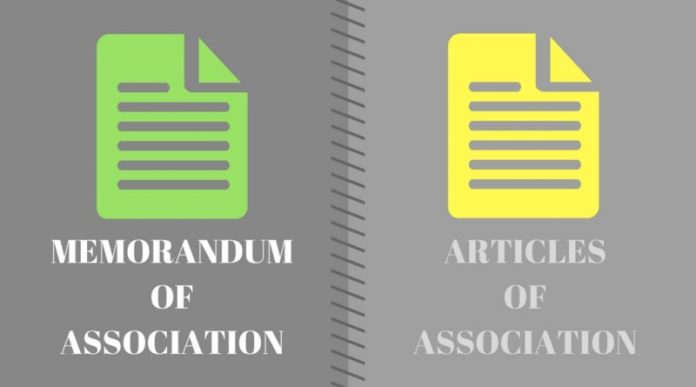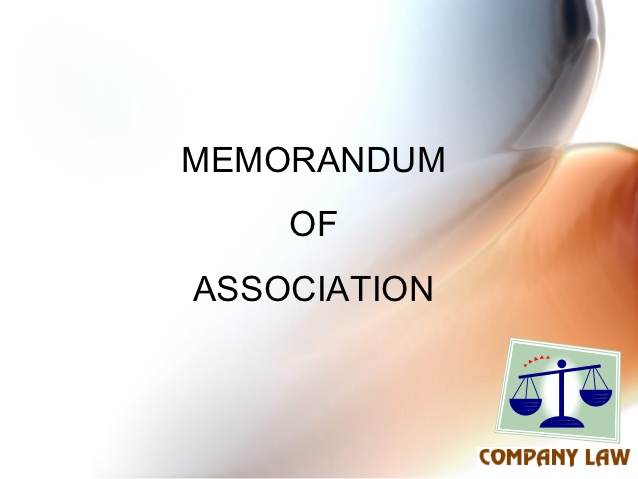This article is written by Ritika Sharma, pursuing B.Com. LL.B. (Hons.) from the University Institute of Legal Studies, Panjab University. The article discusses salient features of the Memorandum of Association and Articles of Association and aims at marking all the differences between the two.
This article has been published by Sneha Mahawar.
Table of Contents
Introduction
The law related to companies was brought to India by the Britishers and it has been evolving since then. Various modifications were made to the company laws via amendments. The establishment of the Companies Act of 2013 was a major success as it incorporated the provisions with respect to disclosure, accountability, and corporate governance. The Act was developed to bring Indian companies on the same pedestal as the companies in the global market. The two significant elements of the Companies Act, 2013 are the Memorandum of Association and the Articles of Association.
A significant question arises as to how these documents are different from each other. While the former lays down the structure of the company and contains the clauses which define the company’s acts, the latter consists of the rules and regulations with which the company works. Apart from their contents, both of these instruments differ from each other in several aspects like registration, procedures regarding alteration, position, binding force, etc.
The following article aims at highlighting the salient features and differences between the two.
Memorandum of Association : the skeleton of a company
Meaning of Memorandum of Association
A Memorandum of Association is the most important document which presents the structure of the company with the help of five clauses as specified under Section 4 of the Companies Act, 2013. It consists of:
- Name clause,
- Registered office clause,
- Objects clause,
- Liability clause,
- Capital clause.
Section 2(56) of the Companies Act, 2013 lays down the meaning of the word memorandum’. It reads, “memorandum means the Memorandum of Association of a company as originally framed or as altered from time to time in pursuance of any previous company law or of this Act”.
Purpose of Memorandum of Association
A Memorandum of Association is a charter on which the framework of a company is based. The main objective behind the framing of the memorandum is to lay down the scope and ambit of powers of the company within which it can function. Anything done outside its ambit is considered void by the application of the doctrine of ultra vires. Therefore, it keeps a check on the powers of the company. The relations of a company with outsiders are defined by this instrument. Also, as the Company Act, 2013 guides this instrument, its contents should conform to the provisions of this statute.
Features of Memorandum of Association
Owing to its significance for the corporations and ambiguous definition under Section 2(56) of the Companies Act, several questions regarding the clauses, the possibility of amendments, binding force, and the consequences for deviating from the memorandum arise. The critical aspects and intricacies of the Memorandum of Association are briefly discussed as follows:
‘Undesirable’ names not allowed
Section 4 specifies that the name of the company should not match with the names of companies already registered and should not nearly resemble them. For instance, in British Diabetic Association v. Diabetic Society Ltd. (1995), the British Diabetic Society Association had to change its name as it was sufficiently similar to another company’s name ‘British Diabetic Society’. Further, in the case of Society of Motor Manufacturers and Traders Ltd v. Motor Manufacturers and Traders Mutual Insurance Co. Ltd. (1925), it was observed that with the registration, a corporation gets a monopoly over its name which excludes every other company to adopt a name similar to it.
Change of name of a company
A company can change its name with the approval of the Central Government and by following the mandates provided under Section 4 and Section 13 of the Company Act, 2013.
Change of registered office
The information regarding the exact place of the registered office should be given to the registrar within 30 days of incorporation or commencement of the business, whichever is earlier. As the alteration in place of registered office could affect several parties such as shareholders, creditors, employees, etc., any change in the place of registered office requires a special resolution and sanction of the Central Government.
Objects of the company
The memorandum contains the objects of a company that should not be against the law and the provisions of the Companies Act. If the company performs functions that are beyond the scope of its objects and powers then the doctrine of ultra vires comes into the picture. For example, in London County Council v. Attorney General (1902), according to the objects and powers clause, the Council had the power to work tramways. Therefore, its act of running omnibuses, even in connection with the tramways, was considered to be ultra vires.
Liability of members
The limited liability of the members could be inferred from the company’s name. The liability of the members can be limited by shares or limited by a guarantee. In the former, members cannot be called to pay anything more than the nominal value of their shares, while in the latter, the members themselves take a guarantee so as to contribute to the assets of the company in the event of its winding up.
Capital of members
The fifth clause requires that the memorandum should state the nominal capital of the company and the divisions and value of shares.
Articles of Association : rulebook of a company
Meaning and purpose of Articles of Association
It is a document containing the rules and bye-laws of a company. Section 2(5) of the Companies Act defines articles as, “articles means the Articles of Association of a company as originally framed or as altered from time to time or applied in pursuance of any previous company law or of this Act”. Articles of Association consist of paragraphs that are signed by every subscriber. The companies can either frame their own articles or adopt Table F from Schedule 1 of the Companies Act. Table F is applicable to a company limited by shares.
Purpose of Articles of Association
The purpose of this document is to smoothen the internal operation of the companies. The rules and regulations specified under the articles help in managing the companies’ internal affairs.
Features of Articles of Association
The following points highlight some of the glaring features of the Articles of Association:
Provisions of entrenchment
According to Section 5 of the Companies Act, the articles may contain provisions regarding retrenchment. They can be added while framing the article or after the formation of the company via amendment.
Alteration
The Articles of Association can be altered with the help of a special resolution. Section 14 of the Companies Act grants this discretion to the companies to alter their articles which includes the power to make alterations with respect to changing a private form of the company into a public company and vice versa. This power is almost absolute with the conditions that the alteration must neither be violating the provisions of the Act nor be abrogating the clauses contained in the Memorandum of Association.
Doctrine of indoor management
The doctrine simply implies that the outsiders are contracting with the company and act with the presumption that the directors of the company are working lawfully. This rule protects the outsiders from the company’s indoor management. This rule was described in the case of Royal British Bank v. Turquand (1856) in the following words, “if the directors have power and authority to bind the company, but certain preliminaries are required to be gone through on the part of the company before that power can be duly exercised, then the person contracting with the directors is not bound to see that all these preliminaries have been observed. He is entitled to presume that the directors are acting lawfully in what they do”.
Differences between Memorandum of Association and Articles of Association
Memorandum of Association, Articles of Association, and prospectus are the most important documents of a company. However, there has always been a great deal of confusion around the differences between memorandum and articles. As already discussed, the memorandum is the skeleton of a company as it carries the five important clauses on which each company is structured and, the articles are the rulebook containing the regulations and bye-laws of a corporation. These two also differ on various other grounds. Let’s delve deeper into those with the help of forthcoming points.
Definition and meaning
Definition of MoA
The meaning of a memorandum is defined under Section 2(56) of the Companies Act, 2013 which does not actually define a memorandum and just calls it something which is originally framed or altered from time to time. Section 4 is the most significant provision with regard to the memorandum which truly defines it by stating its contents.
Definition of AoA
On the other hand, the provision regarding the definition of articles is under Section 2(5) of the Companies Act, 2013. It is interesting to note that this definition matches the definition of memorandum as discussed under Section 2(56), however, Section 5 states that articles contain the regulations for the management of the company and shall also contain any additional matters pivotal to the company’s management.
Position or status
Status of MoA
Since, the Memorandum of Association forms the structure of a company, it is treated to be on a higher pedestal than the articles. It is crucial for the functioning of a corporation. However, it is subordinate to the Company Act, 2013 as specifically stated under Section 6 of the Companies Act. In simple terms, all the clauses contained in the memorandum should comply with the provisions of the Companies Act. For example, the objects stated in the memorandum should not be in contradiction with its provisions.
Status of AoA
On the other hand, the articles of association are subordinate to both the memorandum and the Companies Act, 2013. Thus, articles must not include anything which is against the memorandum. In the case of Bryon v. Metropolitan Saloon Omnibus Co. (1858), the Court stated that “this (the fact that the articles are subordinate to the memorandum) is so because the object of the memorandum is to state the purposes for which the company has been established, while the articles provide the manner in which the company is to be carried on and its proceedings disposed of”. Furthermore, the contents of the articles must be in accordance with the provisions of the Companies Act.
Section 14(3) expressly specifies that in case of the alteration of the articles, the changes are subject to the provisions of the Act. In the case of Madhava Ramchandra Kamath v. Canara Banking Corporation (1940), a company’s Articles of Association contained a provision regarding the expulsion of a member if he/ she unjustly or unlawfully has recourse to law in any matter. A clause was added in the articles which authorised the selling of shares belonging to the expelled member to any third person without any valid instrument. This was held to be in contravention with the Companies Act, 1956, and thus, invalid.
Compulsory filing at the time of registration
It is mandatory to register a memorandum at the time of incorporation. It is a compulsory document that is to be submitted to the registrar. However, filing of the Articles of Association is optional at the time of registration.
Major contents
Major contents of Memorandum of Association
The five clauses, specified under Section 4, form the structure of the memorandum. These are discussed below:
Name clause
Every memorandum should consist of the name of the company. A company, being a legal person, requires a name and it should conform to certain guidelines. Firstly, the name should not be identical or undesirable, in the opinion of the central government. Secondly, the name should not show a connection with the patronage of the central government. Thirdly, the name should not lead to illegal consequences. Fourthly, limited companies should add the word ‘limited’ and private companies should add the word ‘private’ in their names.
It is essential that the name of the company should be painted outside the offices of the company and the companies should use this name on every business document. In Nassau Steam Press v. Tyler (1894), the name of the company was ‘Bastille Syndicate Ltd.’, however, the directors and secretary of the company accepted the bill of exchange by writing it as ‘The Old Paris and Bastille Ltd.’ The Court held that the name was not properly mentioned and the directors and secretary of the company could be made liable. Also, it is pertinent to note that the name of the company should not be regarded as ‘calculated to deceive’.
Registered office clause
Section 12 stipulates the provisions regarding the registered office of the company. The place of the registered office is to be informed to the registrar within 30 days of incorporation of a company and it should be painted outside the office of the company and other conspicuous places. Section 12(9) states that in case the registrar has reasonable cause to conclude that the company is not carrying on any business operations, he/ she can conduct the inspection of the registered office of the company.
Objects clause
The corporations are free to choose their objects unless they are unlawful or contrary to the Companies Act. The reason behind the framing of the objects clause is to inform the shareholders regarding the purposes for which the capital contributed by them is being invested. It also grants the feeling of security to the creditors as they make sure that the capital is spent only on the projects which are connected to the company’s objectives. Therefore, it prevents the diversification of capital.
This gives rise to the doctrine of ultra vires which declares the activities of the company invalid if they are not in consonance with the objects clause. Ashbury Railway Carriage and Iron Co. Ltd. v. Riche (1875) is the first case in which the doctrine was applied. In this case, the objects clause of the company stated “make or sell, or lend on hire, railway carriages, and wagons and all kinds of railway plants, etc, to carry on the business of mechanical engineers and general contractors”. But, the company contracted to finance the construction of a railway line. According to them, this would be within the meaning of ‘general contractors’. However, the House of Lords held that the contract was ultra vires and made an important observation regarding the objects clause which said that there are two functions of the objects, primarily to stipulate the powers of a corporation and secondly to define a boundary within which these powers could be exercised. Further, in the case of Attorney-General v. Great Eastern Railway Co. (1880), it was observed that the objects should be reasonably understood and applied and in the matters concerning the application of the doctrine of ultra vires, the case should be fairly regarded as against the objects clause.
In Re Lee, Brehens & Co. Ltd. (1932), three tests were devised regarding the application of this doctrine.
The Court, in this case, observed that “the validity must be tested by the answer to three pertinent questions:
- Is the transaction reasonably incidental to the carrying on of the company’s business?
- Is it a bona fide transaction?
- Is it done for the benefit and to promote the prosperity of the company?”
In order to avoid the limited scope with respect to freedom of taking actions, the ‘main objects’ rule of construction is applied by the courts while considering the question of ultra vires actions. The consequences of the ultra vires transactions include:
- injunction which can be granted to restrain the ultra vires acts of a company;
- when capital is used by the directors in ultra vires transactions then they are personally liable to replace it;
- in case of breach of warranty, the agents or directors are liable to the third party;
- in case any property is acquired as a result of the ultra vires transaction, the company has the right over such property as it was held by the Madras High Court in the case of Ahmed Sait v. Bank of Mysore (1930) that even though, a company has acquired property outside the scope of its objects, it cannot be forced to give away the right in such property;
- the ultra vires contracts, being outside the scope of objects, are considered null and void.
Liability clause
Section 4(1)(d) of the Companies Act stipulates that the memorandum should state the liability of the members. In the case of companies with limited liability, the clause must state whether the liability is limited by shares or by guarantee.
Capital clause
Section 4(1)(e) of the Companies Act requires that the nominal capital of the company is to be specified in the capital clause. Furthermore, according to Section 4(1)(f), in the case of one person company, this clause should contain the name of the person who is to become a member of the company after the death of the subscriber.
Major contents of Articles of Association
The contents of the articles can be formulated at the discretion of the subscribers to the memorandum of the company, according to the company’s requirements. This can include the provisions that guide the relations between the members inter se or members and the company. But, again, anything stipulated in the Articles of Association should not breach the provisions of the Companies Act. For instance, in the case of Re. Peveril Gold Mines Ltd. (1898), it was held that the shareholders’ right to petition for winding up of the company, as provided under Section 82 of the Company Act, 1862, cannot be taken away by the articles. The articles of a company should be framed with the utmost care, keeping in mind the interests of the stakeholders and the functioning of a corporation. Following are some of the essential contents of the Articles of Association:
Share capital
All the rules regarding the payment of share capital are specified under the articles. The important dates of issuance of certificates, payment of unpaid share capital, etc are mentioned under this clause. Furthermore, it consists of the rights of shareholders.
Lien
In the event of non-payment of the declared amount by the shareholder, the company exercises the option of lien with which the amount already paid by the shareholder is retained by the company. This clause contains the rules regarding the lien on shares. For example, rules specifying an extension of lien to dividends and bonuses, sale of shares retained on a lien, etc are stipulated under this clause.
Transfer of shares
Transfer of shares is executed by the transferor as well as the transferee. This clause contains the provisions regarding the procedure and registration of the transfer of shares. Furthermore, it stipulates the rights of the nominees in case of transmission of shares.
Alteration of capital
The capital can be altered by an ordinary resolution. An ordinary resolution is passed to consolidate and divide share capital into shares, to convert and re-convert fully paid shares into stock, to sub-divide the shares into shares of a smaller amount, and to cancel the shares. All these provisions are mentioned under the alteration of the capital clause.
General meetings
This clause covers the information regarding general meetings and extraordinary general meetings. All the points regarding the calling and functioning of a general meeting are specified. The meetings of the Board of Directors are held for the conduct of the business and in order to adjourn or regulate the meetings of a company.
Directors
The remuneration, powers, and functions performed by the Directors of a company are stipulated under the Articles of Association. Also, it contains the specification with respect to the proceedings of the Board of Directors.
Capitalisation of profits
The rules related to the capitalisation of profits also form an essential element of the Articles of Association. The profits can be utilised for distribution to the shareholders in the form of dividends. Table F states that “the company in general meeting may, upon the recommendation of its Board, resolve that it is desirable to capitalise any part of the amount for the time being standing to the credit of any of the company‘s reserve accounts, or to the credit of the profit and loss account, or otherwise available for distribution”.
Voting rights
It contains voting rights and restrictions on the members of a company. There are different voting rights of the members owing to their age, joint ownership, mental capacity, etc. All these details are specified under this clause.
Winding up of company
All the rules and procedures that guide the winding up of a company are covered under the Articles of Association. The assets of the company are divided amongst the members and trustees. The articles lay down the procedure and extent of division of these assets at the time of winding up of the company.
Additionally, Table F of the Company Act, 2013, contains the format of articles for a limited liability company. It consists of the following clauses:
- Interpretation,
- Share capital and variation of rights,
- Lien,
- Calls on share,
- Transfer of shares,
- Transmission of shares,
- Forfeiture of shares,
- Alteration of capital,
- Capitalisation of profits,
- backBuyback of shares,
- General meetings,
- Proceedings at general meetings,
- Adjournment of meeting,
- Voting rights,
- Proxy,
- Board of directors,
- Proceedings of the Board,
- Chief Executive Officer, manager, company secretary or Chief Financial Officer,
- The seal,
- Dividends and reserve,
- Accounts,
- Winding up, and
- Indemnity.
Mandatory drafting
It is mandatory to draft a memorandum of the company as it is the essential document of a company that presents its layout.
Regarding the Articles of Association, a private limited company has to draft articles while a public limited company can adopt Table F which contains a comprehensive structure of articles. Some of the elements of Table F include share capital and variation of rights, lien, transfer of shares, forfeiture of shares, voting rights, proceedings of the board, accounts, and winding up.
Alteration
The definitions of memorandum and articles are given under Sections 2(56) and 2(5) of the Companies Act respectively, giving them permission to alter these.
Alteration of MoA
The clauses under the memorandum can be altered in accordance with Section 13 of the Act. Section 13(1) stipulates that a memorandum can be altered by passing a special resolution. Additionally, there are different conditions for the alteration of each clause of the memorandum.
Alteration in name clause
In case of alteration of name clause, the conditions stipulated under sub-section (2) and (3) of Section 4 are to be complied with. It also requires the approval of the Central Government. A fresh certificate of incorporation is issued to the company by the registrar after the change of name. In the case of Malhati Tea Syndicate Ltd. v. Revenue Officer (1972), a company filed a writ petition with its old name, even when its new name was entered into the register of joint stock companies. The Court held their petition to be incompetent on this ground alone.
Alteration of registered office clause
The registered office clause of a company can be altered with the approval of the Central Government. The fact that such alteration is taking place with the consent of the stakeholders of the company is taken into account before the approval. In case of a change of registered office from one state to another, the company has to file the certified copy of the order of the central government with both the states. In Mackinnon Mackenzie & Co, re (1966), the company filed a petition to change its registered office from West Bengal to Bombay.
However, the state contended against such a petition on the ground that it would lead to a loss of revenue. The Court while rejecting this contention observed, “there is no statutory right of the state, as a state, to intervene in applications under Section 17 of the Companies Act with regard to change of registered office. If notice has been directed by the court to the State, the State appears pursuant to the notice. If notice is given to secure whether revenues have been paid or not, the court in exercising its discretion sees that a company before removing its office from one State to another does not leave liabilities to the State undischarged. The court in making an order can impose terms to secure discharge of such liabilities”.
Alteration of objects
In case of filing of alteration in objects clause, a special resolution is to be passed by conducting a general meeting. The copy of the special resolution is filed with the registrar who has to certify the same within the span of 30 days. Earlier the approval of the Company Law Board or Central Government was essential, but now the procedure has become much more liberal and it just requires the passing of a special resolution.
Alteration in liability clause
Section 13(11) specifically makes the alteration in the capital void, if the company’s capital is limited by a guarantee and it, via alteration, intends to grant any person (except its members) the right to participate in the divisible profits.
Alteration of AoA
The Articles of Association can be altered in accordance with Section 14 of the Companies Act by a special resolution. It can convert a public company into a private company or vice versa. Additionally, the conversion of a public company into a private company requires approval from the Tribunal. It is also pertinent to note that in case any private company, via alteration, excludes the limitations and restrictions which are significant to include in the articles, then that company would cease to be a private company. The errors in the Articles of Association can also be corrected by altering these. The following points are to be taken into consideration during the process of alteration of the Articles of Association:
- Board of Directors should be informed and a Board meeting is to be organised. The date and time of the general meeting are decided and notice informing the same is sent to the members of the company. According to Section 101 of the Companies Act, a general meeting is called by giving a 21 days’ notice to the members.
- The notice is given to the auditors, directors, and all the members of the company.
- A special resolution is passed in the meeting with a two-thirds majority of the members.
- Within 30 days of the passing of the special resolution, its copy is to be presented before the registrar.
- Alteration should not be unlawful.
- It should not violate the provisions of the Company Act, 2013, and the Memorandum of Association.
- The alteration should not result in the increase in the liability of a company.
The alteration of articles cannot justify the breach of contract. In the leading case of Southern Foundries (1926) Ltd. v. Shirlaw (1940), a person was appointed as the director of the company in the year 1933 for 10 years, however, in 1935 after the amalgamation of the company, it adopted new articles and the person was removed from the post of director. This was challenged and the Court held it to be a breach of agreement and awarded damages to the plaintiff.
Relations
The memorandum contains the conditions which are the basis of the operation of a company and therefore, it handles the relations of the corporation with outsiders like creditors, shareholders, and the public. On the contrary, the articles are the internal regulations and these manage the internal affairs of a company.
Breach
Section 10 of the Companies Act lays down that both memorandum and articles bind the company and its members. However, this Section expresses the contractual force of these two instruments.
Breach of MoA
The acts done beyond the scope of the memorandum are void. The doctrine of ultra vires in the case of the objects clause is the perfect example. The ultra vires acts of the directors, make them personally liable. Also, the court can grant an injunction as to the effect of such ultra vires alteration in the contract.
Breach of AoA
The Articles of Association, being an instrument for managing the internal affairs of a company, have a binding force in cases of agreements between the members inter se and between the members and the corporation. In the case of Wood v. Odessa Waterworks Co. (1889), according to the articles, the directors of the company were required to pay dividends to its members. Then, a resolution, to grant them debenture bonds instead of dividends, was passed. This was held to be a breach of articles as the articles provided for the dividend, i.e., to be paid in cash. Therefore, an injunction was granted and the directors were restrained from acting in this way.
Key differences between Memorandum of Association and Articles of Association
The following points reflect the key differences between these two instruments:
- Memorandum of Association consists of the conditions which are necessary for the registration of a company. On the other hand, the Articles of Association contain the bye-laws of the company.
- Memorandum of Association has an overriding effect over the Articles of Association. Therefore, in the cases of inconsistencies between the two, the memorandum prevails over the articles.
- Memorandum has to be drafted in accordance with Section 4 of the Companies Act, however, there is discretion in formulating the articles of a company.
- The memorandum is to be compulsorily registered at the time of incorporation while there is no such mandate in case of the Articles of Association.
- Doctrine of ultra vires is applicable in the cases where a company functions outside the ambit of its memorandum. This makes the said acts void. However, any activity outside the scope of the Articles of Association can be performed with the consent of the shareholders.
Tabled summary of distinction
| S No. | Basis | Memorandum of Association | Articles of Association |
| 1 | Definition and meaning | The definition of MoA is provided under Section 2(56). It contains the layout of a company in the form of five clauses. | The definition of AoA is provided under Section 2(5). It consists of the regulations and bye-laws of the company. |
| 2 | Position/ status | It is supreme legislation but is subordinate to the provisions of the Companies Act. | Articles are subordinate to both Memorandum of Association and the Companies Act. |
| 3 | Registration/ Filing | It is mandatory to register a memorandum at the time of incorporation. | It is not mandatory to file articles at the time of incorporation. |
| 4 | Major contents | It contains five clauses which are name, registered office, objects, liability, and capital clause. | The contents of articles differ from one company to another. However, Table F can also be adopted. |
| 5 | Mandatory drafting | It is compulsory to draft a memorandum. | A private company has to formulate the Articles of the Association while a public company can adopt Table F of the Companies Act. |
| 6 | Alteration | Alteration of five clauses of the memorandum has different conditions in addition to a special resolution. | Articles can be altered with a special resolution. |
| 7 | Relations | It manages relations of a company with outsiders. | These instruct the internal management of the company. |
| 8 | Breach | Anything done in contrast to the memorandum is void and the doctrine of ultra vires is applicable. | It has a binding force only in respect to the matters between the members inter se and between the members and the company. |
Conclusion
Today, corporations are instrumental in a country’s growth as they provide a boost to the economy. After several major as well as minor amendments in the company laws, the legislation is guiding the companies in managing their businesses. Time and again, new concepts such as corporate social responsibility are introduced so that a balance could be maintained between the working of companies and societal interests.
Both, Memorandum of Association and Articles of Association, are important for a company’s functioning. While one handles the relations of the company with the outsiders such as creditors and other stakeholders, the other regulates internal management. However, articles have always been subordinate to the memorandum. The fact that articles are to be framed in consonance with the five clauses of the memorandum exactly validates this point. Additionally, unlike Articles of Association, the memorandum is to be compulsorily registered at the time of incorporation.
Frequently asked questions (FAQs)
What is the doctrine of constructive notice?
The memorandum and articles are considered to be public documents and therefore, every person who engages with the company, in one form or the other, is required to go through these documents.
The rule of constructive notice simply means that, in addition to having read the company’s documents, any person dealing with the company must have understood its contents in the correct manner. This doctrine is applicable to all the documents of the companies, for example, memorandum, articles, resolutions, etc.
What are the exceptions to the doctrine of indoor management?
This rule protects the outsiders against the company. According to this rule, if the authorities work within the ambit of the articles of the company, then the outsiders contracting with the company can not be made liable on the basis of any irregularity. In the case of Royal British Bank v. Turquand (1856), it was observed that “if the directors have power and authority to bind the company, certain preliminaries are required to be gone through on the part of the company before that power can be duly exercised, then the person contracting with the directors is not bound to see that all these preliminaries have been observed. He is entitled to presume that the directors are acting lawfully in what they do”. The five basic exceptions to this doctrine are knowledge of irregularity, suspicion of irregularity, forgery, representation through articles, and acts performed outside apparent authority.
How a special resolution is passed?
For the alteration of the Memorandum of Association and Articles of Association, a special resolution is passed. It is passed by the voting of two-thirds of members present in the general meeting. The alteration of the Articles of Association can be made restrictive by including an entrenchment clause. The provisions under the entrenchment clause cannot be altered merely by a two-thirds majority.
References
- Singh, Avtar (2018) Company Law, Eastern Book Company, Lucknow.
- https://thecompany.ninja/ashbury-railway-carriage-iron-co-versus-riche-1875/
- https://ebookskenya.co.ke/in-re-lee-behrens-and-co-ltd-1932-eve-j-observed-that-the-validity-of-gratuitous-payments-is-tested-by-the-answers-to-three-pertinent-questions-what-propositions-are-these/
- https://thefactfactor.com/tag/wood-v-odessa-waterworks-co/
- https://corpbiz.io/learning/between-memorandum-of-association-and-articles-of-association/
- https://legodesk.com/legopedia/contents-of-articles-of-association/
https://www.mca.gov.in/Ministry/pdf/CompaniesAct2013.pdf
Students of Lawsikho courses regularly produce writing assignments and work on practical exercises as a part of their coursework and develop themselves in real-life practical skills.
LawSikho has created a telegram group for exchanging legal knowledge, referrals, and various opportunities. You can click on this link and join:
Follow us on Instagram and subscribe to our YouTube channel for more amazing legal content.
 Serato DJ Crack 2025Serato DJ PRO Crack
Serato DJ Crack 2025Serato DJ PRO Crack














 Allow notifications
Allow notifications


